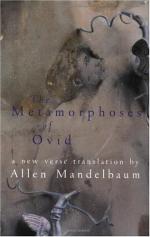|
This section contains 359 words (approx. 1 page at 400 words per page) |

|
Dactylic Hexameters
Dactylic hexameter is the meter that traditionally was used in Greek and Latin epic poetry. From the Greek meaning "finger," a dactyl is a metrical arrangement that consists of one stressed syllable followed by two unstressed syllables. Hexameter literally means "six metra." The term dactylic hexameter is a metrical pattern that per line consists of six successive dactyls. Virgil's Aenid is an example of an epic written in dactylic hexameters. Beginning with the second line of the Metamorphoses, Ovid employs dactylic hexameter for his epic.
Epic
An epic is a long poem that deals with mythical, legendary, or historical events, or a combination of the three. Homer is considered to be the first, and arguably greatest, epic poet. Although the stories that make up the Metamorphoses do not form a single narrative wholethat is, while the stories may be linked thematically, they are not connected sequentially...
|
This section contains 359 words (approx. 1 page at 400 words per page) |

|




